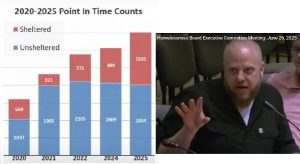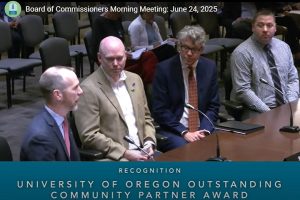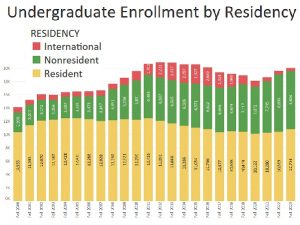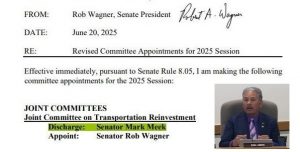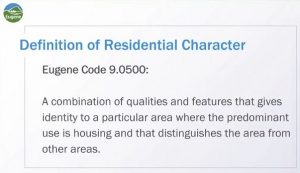Chamber, business leaders encourage city, county to prioritize housing
13 min read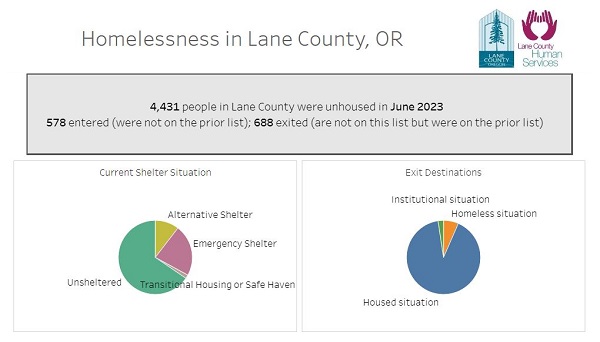
At the City Club July 28, the business community looks for one plan to address homelessness, with a comprehensive cost analysis coming this fall.
Kaarin Knudson (City Club program coordinator): ‘Rare, brief, and nonrecurring.’ These are the words that are used to describe homelessness in communities that have worked to end it. These are not the words used to describe homelessness in Eugene, at least not yet.
[00:00:25] In 2019, an analysis of federal data confirmed that Eugene had the worst per capita homelessness rate in the nation, ahead of both Los Angeles, who’s number two, and New York City, who’s number three.
[00:00:37] In comparison with other U.S. cities, looking at the same data, Eugene has 432 people experiencing homelessness per 100,000. For reference, Oregon’s rate overall is 350 people per 100,000.
[00:00:53] In June (2023), according to Lane County, 4,531 people were experiencing homelessness countywide. Just over 3,600 of those people were living in unsheltered conditions, 80%.
[00:01:07] Here to share recommendations from the Eugene Area Chamber of Commerce’s research, the City Club welcomes three speakers.
[00:01:17] Brittany Quick-Warner (Eugene Area Chamber of Commerce, president and CEO): In 2020, as the pandemic was consuming our community, we, like many other communities across the country, as our shelters had to reduce their inventories, the visibility of our unsheltered homeless crisis increased. Unsanctioned camping across the community became much more prevalent, and we started getting a lot more calls.
I was picking up the phone on a regular basis from business leaders asking, ‘What is the Chamber doing about homelessness?’ This is one of the biggest issues facing not only our broader community, but our business community as well.
[00:01:50] So we set out on a path to learn more. Over the period of about four months, we met with over 200 community members, nonprofit directors who work in this space every single day, city and county staff, law enforcement, neighbors, business leaders, and unhoused individuals themselves to better understand what our current system looked like, what was working, and what needed to be changed.
[00:02:12] With that information and research that we did and best practices gathered from communities across the country, we published the State Of Our Homeless Crisis.
[00:02:20] We summarized our findings into eight recommendations.
- We needed better, quality data. In order to really solve a hairy crisis, you’ve got to understand it as best as you possibly can.
- We had to identify a shared goal, a vision that we could all get behind and then come together as a community to achieve that.
- We have to figure out how to increase service provider capacity. There are groups in this community who are doing this work day in and day out who are underresourced and overworked and we have to fix that if we’re going to fix our system.
- We have to address the lack of resources for both shelter and affordable housing.
[00:02:56] John Q: Number five is outreach and case management.
Brittany Quick-Warner: 6. We need to increase our wraparound services. Just getting folks into housing or shelter is not enough. We have to provide them the services they need to actually get well.
7. We have to address enforcement and accountability.
8. And the last but I think one of the most important things is we need to rebuild community trust. One of the things we heard over and over and over again is that people are losing hope that we can even do anything about this crisis and a community that is hopeless will never achieve what it is we have to achieve here.
[00:03:30] We did feel like there were a few key areas that we could contribute to help move us forward. The first was to launch a Business Leaders Task Force. We wanted to bring the business community into the conversation to help figure out where they could plug in to be the most helpful.
[00:03:44] The second, we wanted to conduct a cost study so, we got agreement from the City of Eugene, Lane County, and the City of Springfield, and a few others, to conduct this cost analysis of our homeless system. Our goal is to aggregate information and data about all the different funding sources that we currently have, and the uses of those funds in our community into one place so community members can better understand the funding mechanisms our system is supported by.
[00:04:09] This work is nearing completion and we hope to have a report out in the fall this year.
[00:04:14] We have over a dozen plans in this community that touch on some sort of tactics around how to solve this crisis. And that’s part of the problem. We have a dozen plans. We need one shared plan that the broader community can understand and wrap their heads around. So we’re taking those dozen or so plans that currently exist and boiling down to the key areas: shelter, wraparound services, nonprofit capacity, employment, public safety, housing.
[00:04:41] Plans are worthless without someone being held accountable to actually achieving them. And we have to understand what governance model in our community is going to help us do that. Sometimes our government and our nonprofit providers are not in alignment around which policies need to be happening and need to be implemented in order to do this work.
[00:05:01] The plans that we’ve established in the past, we might have said, ‘Well, we need 6,000 more units or we need to build X number of affordable, but we’ve never gone as far as saying, ‘Okay, but how do we actually change our policies to make that possible and affordable?’ And this is the hard part, right? So, we have to be willing as a community to do the hard part as well, which is actually aligning our policies with what our goals are around this.
[00:05:25] We have to understand where the money we’re currently spending is going, where the gaps are, and if we need more resources as a community, what we can agree to do to make that happen.
[00:05:35] And lastly, how do we communicate the plan out to the community so they have a sense of hope that we’re actually going to get something done, that we’re in alignment, that we’re moving in the same direction, and that we’re transparent enough to share those measurables and those goals and report out on how we’re doing.
[00:05:50] Kaarin Knudson (City Club program coordinator): Karen Sachs is DevNW’s Director of Policy, Advocacy, and Strategic Relationships.
[00:05:55] Karen Sachs: My name is Karen Sachs. DevNW is an affordable housing developer, both for rental and ownership, and an asset-building organization serving Lane (County) and six other counties in Oregon.
[00:06:06] The Oregon Housing Needs Analysis estimates that there’s a current shortage of almost 140,000 homes across the state and a projected shortage of over 400,000 homes over the next 20 years. Upon taking office, Governor Kotek signed two executive orders, one of which established a statewide housing production goal of 36,000 new units each year for the next 10 years, with at least half of those being accessible to people who are 80% below the medium area income.
[00:06:36] These homes are needed across the continuum, from affordable rental to affordable homes for ownership to middle income and market rate units. The crisis in the supply of housing is showing up here starkly. The average rent for a one-bedroom apartment in Eugene is over $1,300. For a family-sized three-bedroom, it’s almost $2,300 a month.
[00:07:01] And that’s honestly if you can find an apartment to rent. Vacancy rates have hovered around 1%-to-2% consistently in this community.
[00:07:10] And the home ownership side doesn’t look much better. Median sale prices are around $490,000. And homes are selling within seven days. So these numbers tell the story of a market that is not providing entry to low- and moderate-income renters or homeowners.
[00:07:28] Years of disinvestment into housing production coupled with wages that are not keeping up with housing costs are pushing people further into housing instability and stagnation. We work with renters on a daily basis who are trying to get into homeownership. They want to become first-time homebuyers, but as they’re paying 40% to 50% of their income on rent, they cannot save for a down payment. It gets pushed further and further out of reach.
[00:07:56] For a family that’s seeing that house priced at $490,000, they need to come up with close to $100,000 in savings or other funds for a down payment to avoid mortgage insurance. And given the cost of everything from groceries to transportation to childcare, that can be an insurmountable hill to climb.
[00:08:17] What do we need to do? We must increase the availability of affordable units across the housing continuum. We have to ensure that people can move throughout the continuum as their needs change. And our current housing market is not allowing them to do that.
[00:08:32] So to do this, it means local investment into housing development. Having flexible, local resources can be a game-changer. It not only demonstrates local support for a project, but it also enables unique projects that better fit local need to move forward.
[00:08:49] We need to have by-right affordable housing development, which means removing arcane land use and site design requirements that has led to slow and cumbersome development. We shouldn’t have to wonder whether a project will be blocked because the landscaping strip next to the driveway is 18 inches too narrow.
[00:09:07] And it also means combating NIMBYism that shows up very strongly at the local level. It’s about changing the narrative around housing. Housing should not be a luxury. The longer we block housing development, the more acute the crisis becomes.
[00:09:23] Access to housing supports our whole community, from the families that want to put down roots here to the entrepreneurs who shouldn’t have to choose between starting their own business or buying a home, and to the employers who can then rely on a more stable workforce.
[00:09:38] Kaarin Knudson (City Club program coordinator): Mike Coughlin is a member of the Chamber’s Business Leaders Task Force on Homelessness and owner and CEO of Burley Design.
[00:09:45] Mike Coughlin (Business Leaders Task Force on Homelessness): My name is Mike Coughlin and I wanted to talk a little bit quickly about a book that all of our groups have been reading, and it’s called Homelessness Is a Housing Problem. And it was written by an associate professor at UW, Gregg Colburn, and a data scientist, Clayton Aldern, and we were fortunate enough through one of our Business Task Force groups to have Gregg present a little bit about his book and the cause of homelessness.
[00:10:09] So I wanted to just quickly talk about a few myths that people are hearing about or talking about and really get to the core of the issue.
[00:10:15] We hear about poverty causing homelessness, mental health causing homelessness, drug addiction causing homelessness, unemployment rates, serious mental illness. And there was no correlation between homelessness and these different issues. There were no correlations whatsoever. So you kind of scratch your head saying, ‘What’s going on?’
[00:10:35] So what they discovered was, after crunching all this data, that vacancy rates in your local community and your rental rates are the main cause of homelessness. And if you look at Eugene, you look at Seattle, Portland, San Francisco, LA, they all have high housing costs and very low vacancy rates. In fact, economists will tell you that if you have a vacancy rate in your community that’s less than 5% that you do not have enough housing in your community. Under 5% vacancy, you also are now at risk of homelessness in your community.
[00:11:09] If you go back to the book, they talked about the main issues on the supply side were regulatory and topography, believe it or not, topography. So, we’ve got the South Hills, and it’s not easy to build in the South Hills, yet we have a Envision Eugene study that shows that there’s hundreds of building sites up there when really it’s not. You need flat ground, with easy access to bus routes and retail shopping centers.
[00:11:36] And then on the regulatory side, it is difficult to build. We’ve got not only the Eugene Building Code, but we have, I don’t know, 14 or 16 different overlays over the building codes. And so we have neighborhood associations that have actually tweaked the code specifically for their neighborhoods. We’ve taken that and just really made it into a mess.
[00:11:54] And if you talk to any affordable housing providers in here, it costs 20% to 25% more to build the exact same apartment. This one’s an affordable housing unit and this one’s not an affordable housing unit. Affordable housing providers have a lot of other hoops to jump through and it just, it drives the cost of this stuff up.
[00:12:12] We’re sitting in a situation where we know we have extremely low vacancies, extremely high rents, and that’s not going to go away anytime soon. It’s been consuming our police department, our fire department, our park service, parking, our nonprofits have been run ragged. They can’t get the staffing. We can’t get enough nonprofits to even open safe sleep sites.
[00:12:33] A lot of cities are starting to suffer because of this. Salem just put in a payroll tax to cover their police and homeless efforts. Corvallis closed a shelter because they didn’t know about their funding. And I just read this morning that in Eastern Oregon we’ve got some cities that are also closing shelters because they don’t have any funding. This is not a government problem, it’s a community problem that we have to deal with. And we have to look at it at a community level.
[00:13:00] What we’re driving for, is to get everybody at the table and have an overarching plan. Because it’s an expensive problem and it’s not going to go away.
[00:13:08] We need to get our city councilors and Lane County commissioners together and make housing a priority. You know, we’ve got rules that we’re going against landlords for, to protect tenants. And we’ve got all sorts of committees that talk about housing, but we don’t really have a group that’s focused on building housing, and with the funding. We need to make that a priority because that’s the solution to our problem. We’ve been buried in trying to just handle what’s been happening over the last three or four years.
[00:13:40] The governor’s plan, the $200 million ‘All-In’ plan, $200 million is not even a drop in the bucket to address this situation. That goal, across the whole state, they want to take 600 people off the streets. That was one of the goals, across the whole state with that money. We’ve got 3,000 people in Eugene living on the streets. It is a drop in the bucket and a lot of this one-time funding from ARPA, you know, the COVID money, it’s going to go away.
[00:14:12] And so we’ve got to have a plan if we want to be successful, that everybody’s got to be together. As a community, we’ve got to come together with one plan because that’s going to give us strength if we need to go try to raise a tax for this or a tax for that and we’re going to get grants to build housing and support these folks.
[00:14:30] Fay Venus: My name is Fay Venus. I’m an advocate for living. I’m also a co-founder of Community Supported Shelters. I was blessed to create an amazing organization with Eric (de Buhr). We started with nothing. We had no money. We had passion and we had love and we had care for our community. And I believe that if there’s the right people at the table around this topic that we can create solutions and come up with solutions that are going to be less costly to the community. They’re going to be more integrated. They’re going to be more thoughtful and caring for the people that are really struggling.
[00:15:06] I’m really passionate about this topic and I’d like to invite us to come together in our hearts with our passion around this topic and not commodify it around money and action will only happen around money.
[00:15:21] Jerry Smith: I’m Jerry Smith, a City Club member. I’m a social worker and have been since 1965 working with the homeless. When we had welfare programs, much disdained by the very rich, there was grant money always aimed at housing.
[00:15:39] The current remainder of the welfare programs like SSI (Supplemental Security Income) don’t have in their total amount enough to cover rent. And that’s part of the problem. We have literally abandoned the poor. It is a question of poverty and of abandonment. There is no agency now.
[00:16:01] We used to have AFDC and care for children, but as housing became a problem, the workers said, we cannot handle problems of housing, so they disregarded those people. That happened to the disabled people. That happened to elderly people.
[00:16:25] All last winter, I was working with an older woman in a wheelchair. She was outside all winter. No one would take her. When she was lucky, she had a tarp to cover at night. She used to be down at the library. The city’s gotten crazy about shutting things down. She used to live at the library. She doesn’t have that overhang anymore.
[00:16:51] There is no agency for the homeless. That’s the craziest thing we could possibly imagine. If we knew who they were and what their problems are, I see them twice a week. I know some of their problems. I can refer them somewhere, but there is no place.
[00:17:12] What we need to do is recognize they’re out there and they need to be safe. Nobody, now, no one talked about caring about them as disabled, hurt, lonely, abandoned people who’ve been years in the woods, many of them, and there’s no opportunity for them to go anywhere. We need an agency that focuses on dealing with people abandoned and homeless.
[00:17:41] John Q: Local business leaders link homelessness to the amount of available housing. The Chamber will share its cost analysis of the homeless system this fall.
